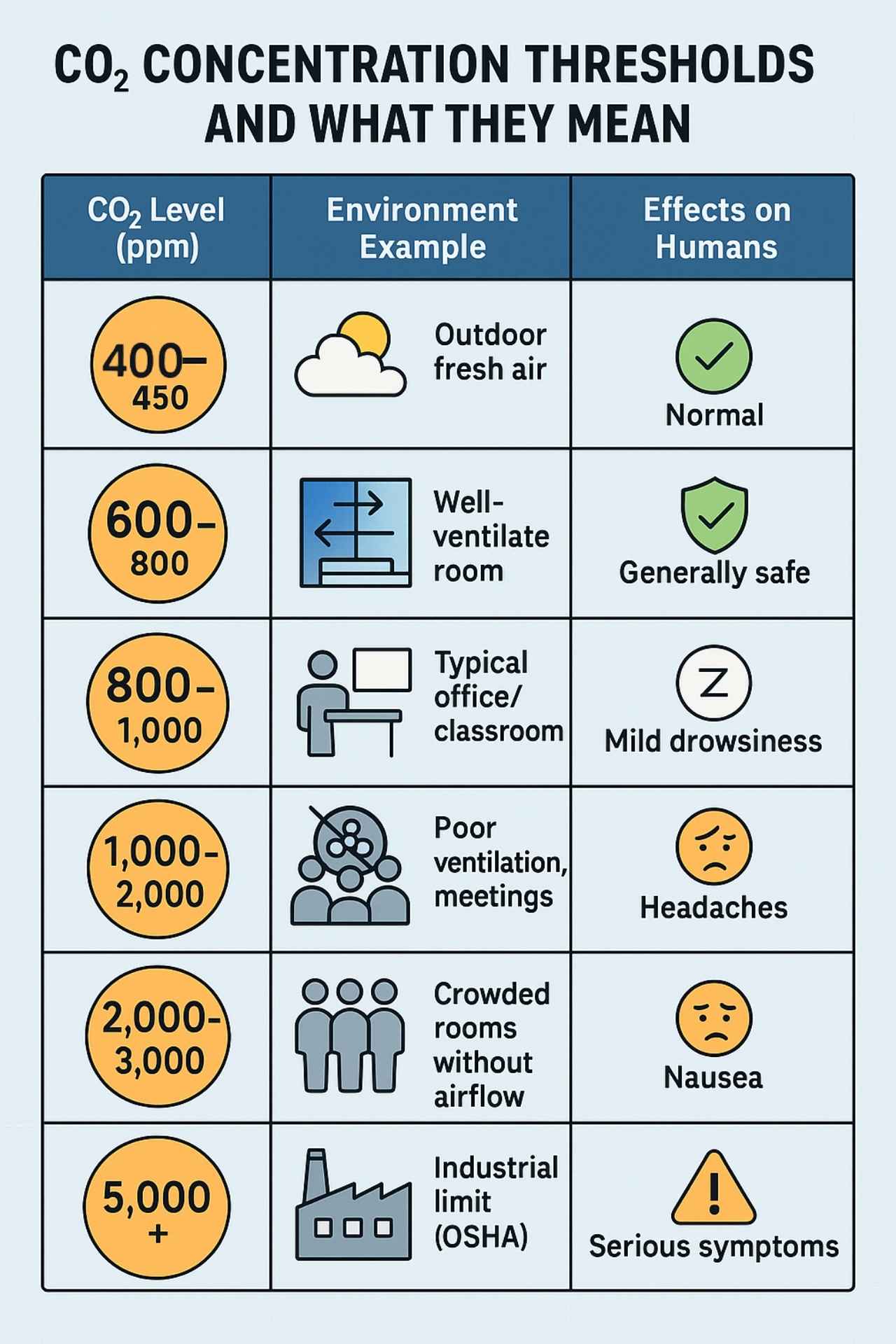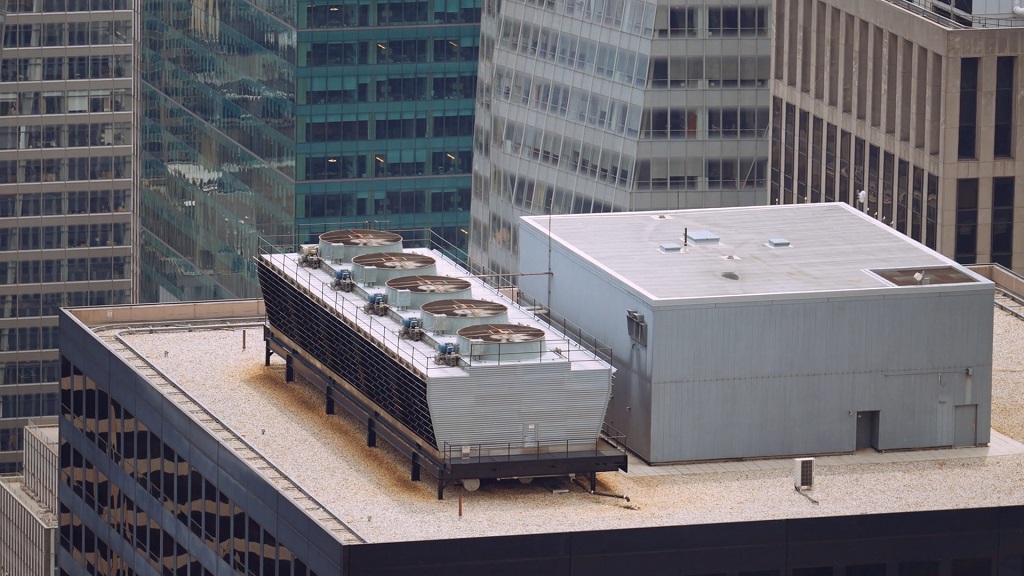When people think of air pollution, they often picture smoggy cities or factory emissions. But indoor air can degrade just as quickly, and one of the most overlooked culprits is carbon dioxide (CO₂). Indoors, CO₂ is primarily generated by people simply breathing.
In a closed room with poor air circulation, CO₂ can accumulate rapidly, often reaching levels that impact health and performance within an hour.
According to a study by Satish et al. (2012), CO₂ levels in a typical office or classroom can exceed 1,000 parts per million (ppm) in less than 45 minutes if windows are shut and HVAC systems are off or poorly designed. Outdoor CO₂ levels usually hover around 400–420 ppm.
But indoors, without fresh air exchange, levels can rise to 2,000–3,000 ppm in crowded spaces – enough to cause drowsiness, headaches, and measurable cognitive decline.
What Causes Indoor CO₂ Buildup

CO₂ indoors is primarily generated by people exhaling. Each person exhales about 0.004 cubic meters of CO₂ per minute (or roughly 20 liters per hour), depending on activity level.
In tightly sealed spaces like modern homes, classrooms, or conference rooms, this CO₂ has nowhere to go unless it’s actively removed through ventilation.
Other minor sources of indoor CO₂ can include:
- Gas stoves or fireplaces (combustion)
- Cigarette smoke
- Some industrial or lab equipment
However, in most settings, like offices or homes, human respiration is the dominant source.
Why Poor Air Circulation Is the Main Contributor

CO₂ is a natural byproduct of respiration, but problems only arise when the air exchange rate is too low. Poor air circulation means that stale air – containing CO₂ and other exhaled gases – is not replaced with fresh outdoor air.
Factors that reduce air circulation:
- Closed windows and doors
- Lack of mechanical ventilation or HVAC systems
- Blocked air vents
- High room occupancy
ASHRAE Standard 62.1 recommends ventilation rates of at least 20 cubic feet per minute (CFM) per person in offices to maintain indoor air quality. Without it, CO₂ concentrations rise quickly, especially in tightly sealed energy-efficient HVAC systems and buildings.
How High CO₂ Affects Health, Focus, Sleep, and Thinking
Elevated CO₂ levels may not be toxic like carbon monoxide, but they are far from harmless. Numerous peer-reviewed studies show that even moderate increases in CO₂ can impair brain function.
Symptoms at Elevated CO₂ Levels:
- 800–1,000 ppm: reduced comfort, early signs of drowsiness
- 1,000–2,000 ppm: fatigue, poor concentration, headaches
- 2,000–5,000 ppm: cognitive impairment, sleep disturbances, nausea
- 5,000+ ppm: OSHA exposure limit; long-term exposure may be hazardous

In a Harvard T.H. Chan School of Public Health study (Allen et al., 2016), workers in a controlled environment exposed to 1,400 ppm CO₂ showed 50% lower scores on decision-making tasks compared to when CO₂ was maintained at 600 ppm.
High CO₂ can also:
- Worsen sleep quality by disrupting REM sleep
- Trigger mild acidosis (CO₂ is acidic in the bloodstream)
- Increase heart rate and respiratory rate
In addition to cognitive effects, elevated CO₂ levels can significantly influence physical well-being and long-term health.
When carbon dioxide concentrations remain high indoors – particularly in spaces with poor ventilation such as bedrooms, offices, classrooms, or vehicles – people may experience persistent symptoms like brain fog, irritability, and morning grogginess.
This is because CO₂ accumulation at night can reduce oxygen availability, especially during deep and REM sleep, when brain oxygen needs are highest.
Over time, poor-quality sleep linked to high CO₂ may contribute to chronic fatigue, reduced immune function, and increased vulnerability to mood disorders such as anxiety and depression.
Children and older adults are especially sensitive to these effects. Studies show that in classrooms with CO₂ levels over 1,000 ppm, children perform significantly worse on concentration and problem-solving tasks.
Similarly, elderly individuals may experience worsened sleep apnea or elevated blood pressure when exposed to CO₂-rich air overnight. High CO₂ can also affect thermal comfort and perception, making rooms feel stuffy or oppressive even when the temperature is normal.
Unlike outdoor air, which typically contains around 400 ppm CO₂, indoor air can rise above 2,000 ppm in poorly ventilated rooms after just a few hours of occupancy, making regular ventilation a critical part of maintaining cognitive clarity and overall health.
CO₂ Concentration Thresholds and What They Mean
| CO₂ Level (ppm) | Environment Example | Effects on Humans |
| 400–450 | Outdoor fresh air | Normal, no symptoms |
| 600–800 | Well-ventilated room | Slightly elevated, generally safe |
| 800–1,000 | Typical office/classroom | Mild drowsiness, drop in performance |
| 1,000–2,000 | Poor ventilation, meetings | Headaches, fatigue, reduced decision-making ability |
| 2,000–3,000 | Crowded rooms without airflow | Nausea, irritability, cognitive sluggishness |
| 5,000+ | Industrial limit (OSHA) | Unsafe for prolonged exposure; serious symptoms are possible |

400–450 ppm: Outdoor Fresh Air
This is the baseline CO₂ level found in clean, natural outdoor environments. It reflects what human physiology evolved to tolerate and functions as the reference point for indoor air quality standards.
At this range, people feel alert, comfortable, and free of symptoms. Any deviation upward begins to impact air freshness and oxygen availability.
600–800 ppm: Well-Ventilated Indoor Space
This range is generally considered safe and acceptable for homes, offices, and schools. Although CO₂ is slightly elevated compared to the outdoors, symptoms are negligible. Cognitive performance remains strong, and occupants rarely report discomfort.
However, the fact that CO₂ rises this much with moderate indoor occupancy highlights how quickly stale air can accumulate without active ventilation or CO₂ monitoring.
800–1,000 ppm: Common Office or Classroom
This is the most commonly recorded range in shared indoor spaces, particularly in older buildings or during colder seasons when windows remain closed. Research shows that around 1,000 ppm, cognitive function starts to decline measurably.
People often report drowsiness and minor loss of concentration. In schools, this level has been associated with reduced test scores and slower response times, especially in tasks requiring memory and critical thinking.
1,000–2,000 ppm: Poorly Ventilated Rooms
This range is often reached in meeting rooms, waiting areas, or classrooms during long sessions with little or no airflow. At this level, clear physiological symptoms appear, including headaches, fatigue, and eye or throat irritation.
Studies (e.g., Allen et al., 2016) have found a 15–50% drop in decision-making scores when CO₂ climbs within this band. For workplaces, productivity and error rates are negatively affected, and complaints about discomfort increase
2,000–3,000 ppm: Crowded, Stagnant Airspaces
This is a serious threshold where air becomes visibly “stuffy” and physical discomfort becomes pronounced. People in rooms with CO₂ levels above 2,000 ppm often report nausea, irritability, and dizziness, along with cognitive dulling.
These levels are commonly seen in gyms, lecture halls, or conference rooms with no HVAC systems running. This range can also begin to disturb sleep cycles and cause shallow breathing, especially in vulnerable populations.
5,000+ ppm: OSHA Exposure Limit
The Occupational Safety and Health Administration (OSHA) defines 5,000 ppm as the maximum permissible exposure over an 8-hour work shift. Any exposure beyond this point is considered unsafe. Long-term exposure can lead to respiratory acidosis, a condition in which CO₂ buildup lowers blood pH.
It may also raise heart rate, increase anxiety levels, and cause more severe respiratory distress. Such concentrations are typically found only in industrial or laboratory environments or sealed rooms with absolutely no ventilation.
Real-World CO₂ Measurements: Comparing Ventilated and Poorly Ventilated Rooms
Indoor CO₂ buildup varies significantly depending on the quality of ventilation and the number of occupants.
In real-world environments like classrooms, bedrooms, and meeting rooms, the difference between well-ventilated and poorly ventilated spaces can be stark, often exceeding thresholds that affect concentration, comfort, and health.
In a typical classroom setting with 25 students and one teacher, CO₂ levels offer a clear example of this disparity.

When windows are open and a functioning HVAC system circulates fresh air, CO₂ concentrations remain relatively stable, averaging around 850 ppm. This level is within the acceptable comfort range and unlikely to impair concentration.
However, once the same classroom is sealed off – windows closed and HVAC turned off – the CO₂ concentration rises dramatically.
Within one hour, levels can spike to between 1,800 and 2,400 ppm, pushing well past the point where cognitive function and comfort begin to decline.
A similar pattern emerges in a residential setting. Consider a small bedroom occupied by two people overnight. With the door fully closed, CO₂ levels at bedtime may begin around 500 ppm. However, after seven hours of sleep, levels can climb as high as 2,000 ppm.
This amount of buildup is enough to disturb sleep quality and increase feelings of grogginess upon waking.
By simply keeping the bedroom door ajar during the night, these concentrations can be reduced significantly, typically stabilizing between 1,000 and 1,200 ppm, a range associated with improved rest and better morning alertness.
In office meeting rooms, where space is limited and occupancy can be high, the effects of poor ventilation are also measurable. A sealed room with six occupants and no active ventilation will quickly reach CO₂ levels above 2,000 ppm after just one hour.
However, when an HVAC system is configured to provide active fresh-air exchange rather than just recirculation, the CO₂ concentration can be maintained below 900 ppm, allowing for clearer thinking and sustained attention during meetings.
These scenarios reflect typical indoor conditions and underscore the importance of continuous ventilation in both residential and commercial spaces. The table below summarizes these comparisons:
| Environment | Ventilation Status | CO₂ Level After 1 Hour / Overnight |
| Classroom (25 students + teacher) | Open windows + HVAC | ~850 ppm |
| Windows closed, no HVAC | 1,800–2,400 ppm | |
| Small Bedroom (2 sleeping adults) | Door ajar | 1,000–1,200 ppm (after 7 hours) |
| Door closed | 1,800–2,000 ppm (after 7 hours) | |
| Office Meeting Room (6 people) | HVAC on (fresh air flow) | <900 ppm |
| HVAC off, sealed room | >2,000 ppm |
Improving Indoor Air Circulation and Reducing CO₂ Accumulation
Effective air circulation is the cornerstone of managing indoor CO₂ levels. Without sufficient airflow, carbon dioxide accumulates rapidly, even in rooms with average occupancy.
Several strategies exist to address this problem, ranging from mechanical systems to behavioral adjustments.
One of the most effective long-term solutions is the use of mechanical ventilation systems such as HVAC units that are configured to introduce outside air rather than simply recirculate indoor air. For these systems to remain effective, regular maintenance is essential.
Clogged filters, malfunctioning fans, and outdated control settings can severely reduce their capacity to expel CO₂ and bring in fresh air. Building managers should ensure that their HVAC systems meet the minimum outdoor air ventilation rates recommended by standards such as ASHRAE 62.1.
In environments without mechanical systems or where energy savings lead to limited HVAC use, opening windows and doors periodically remains a highly effective alternative.
Cross-ventilation, where openings on opposite sides of a room allow for the flow of outside air through the space, is particularly beneficial in reducing localized CO₂ buildup.
Even short periods of natural ventilation during breaks or between activities can drastically lower airborne CO₂ concentrations.
Installing real-time CO₂ monitors can provide valuable feedback on indoor air quality. Devices such as the Aranet4, Awair, or Netatmo monitor carbon dioxide levels and alert users when values exceed safe thresholds.
These devices are especially useful in classrooms, bedrooms, and shared workspaces, helping occupants respond promptly by opening windows or reducing room occupancy. A general target should be to maintain indoor CO₂ levels under 1,000 ppm for optimal comfort and mental performance.
While air purifiers with HEPA filters are highly effective for removing airborne particles, allergens, and volatile organic compounds, they do not remove CO₂.
Some advanced air purification systems that integrate energy recovery ventilation (ERV) or heat recovery ventilation (HRV) technologies can simultaneously filter and refresh air, making them more suitable for managing carbon dioxide levels in enclosed environments.
Reducing the number of people in small or poorly ventilated rooms is another straightforward way to prevent CO₂ spikes. This strategy is especially relevant in small meeting rooms, conference calls conducted from home offices, and study groups in dormitory settings.
Each additional person adds approximately 20 liters of CO₂ per hour, so reducing occupancy can have a significant impact on air quality in tight spaces.
Role of HVAC Systems, Air Purifiers, and CO₂ Monitors

| Tool | Function |
| HVAC System | Exchanges indoor air with outdoor air (if configured for ventilation) |
| Air Purifier | Removes particulate pollutants, not CO₂ |
| ERV/HRV Units | Energy-efficient fresh air exchangers that help manage CO₂ and humidity |
| CO₂ Monitor | Real-time feedback on air quality helps trigger window opening or fan use |
| Ceiling/Window Fans | Improve airflow circulation, useful when combined with open windows |
Actionable Tips for Homes, Schools, and Offices
- Homeowners: Install a CO₂ monitor in the bedroom. Sleep with the door cracked or run an ERV system if possible.
- Teachers: Open windows during breaks or rotate classroom doors. Place a CO₂ monitor on the wall and show students the values – it’s a teaching opportunity.
- Building Managers: Upgrade HVAC systems to meet ASHRAE Standard 62.1. Conduct regular CO₂ audits, especially in conference rooms and open-plan offices.
- Everyone: Watch for signs like frequent yawning, headaches, or stale air – these may indicate poor ventilation.
Final Thoughts
Indoor CO₂ levels are a hidden yet powerful indicator of air quality, affecting everything from your sleep to your ability to think clearly. Poor air circulation is the primary reason CO₂ builds up, especially in modern, energy-efficient buildings.
The good news is that it’s measurable and manageable, with the right tools and habits.
Keep your CO₂ under 1,000 ppm for optimal health and performance. Whether by opening windows, adjusting HVAC settings, or using monitors to stay informed, better air quality is both achievable and essential.

